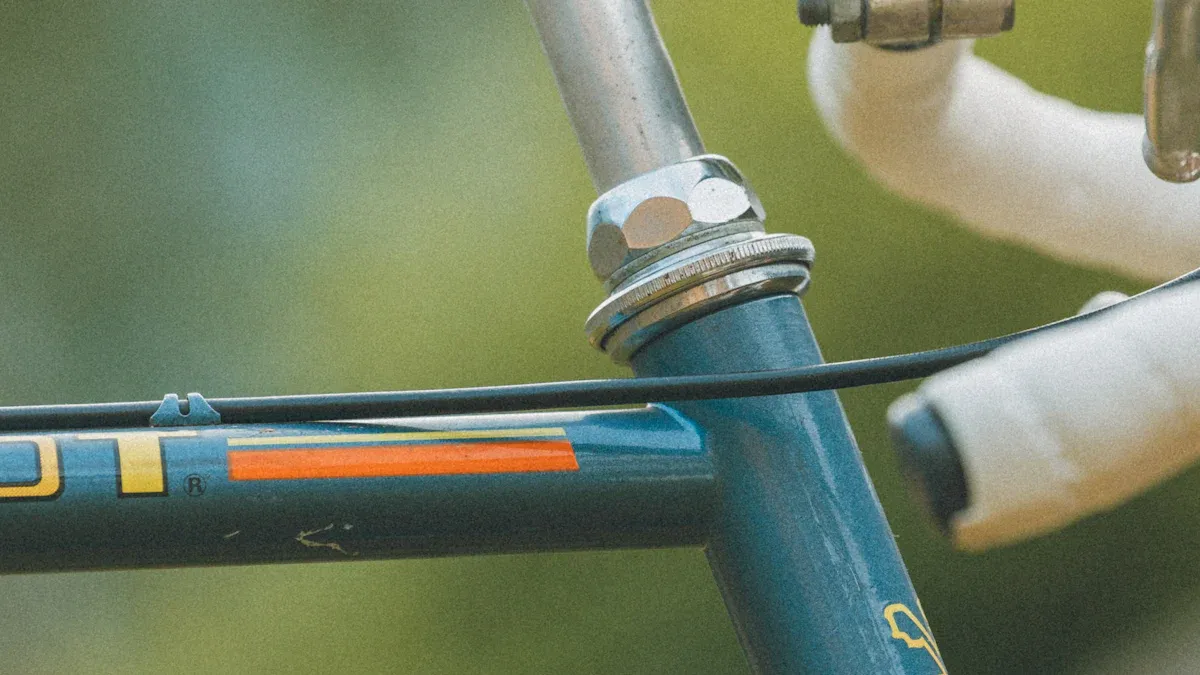
Have you ever thought about why your bike feels shaky or why riding gets hard after some time? Knowing bike frame parts helps you see problems early. Checking important bike parts often can help stop accidents. Only about 2% of bike accidents happen because something breaks, as you can see in the table below. Learning about the main parts of a bike, like the bike frame, keeps you safer and more comfortable. Knowing how a bike is built helps you make good choices when fixing or upgrading your bike.
Contributory Factor (Vehicle Defects) | Approximate Percentage of Reported Accidents |
|---|---|
Overall vehicle defects | ~2% |
Defective brakes | ~1% |
Frame-specific failures | Very low or negligible |
You can ride better and have more control when you know about bike parts and how they work together.
Key Takeaways
If you know your bike frame parts, you can find problems early. This helps you ride safer and feel more comfortable. The frame, fork, headset, stem, and handlebars all work together. They change how your bike moves and feels. Picking good materials and parts, like seatposts and saddles, makes long rides more comfortable. You should check and take care of the drivetrain, wheels, and brakes often. This keeps your bike working well and safe. If you understand bike parts, you can choose better when you buy, upgrade, or fix your bike.
Bike Frame Parts Overview
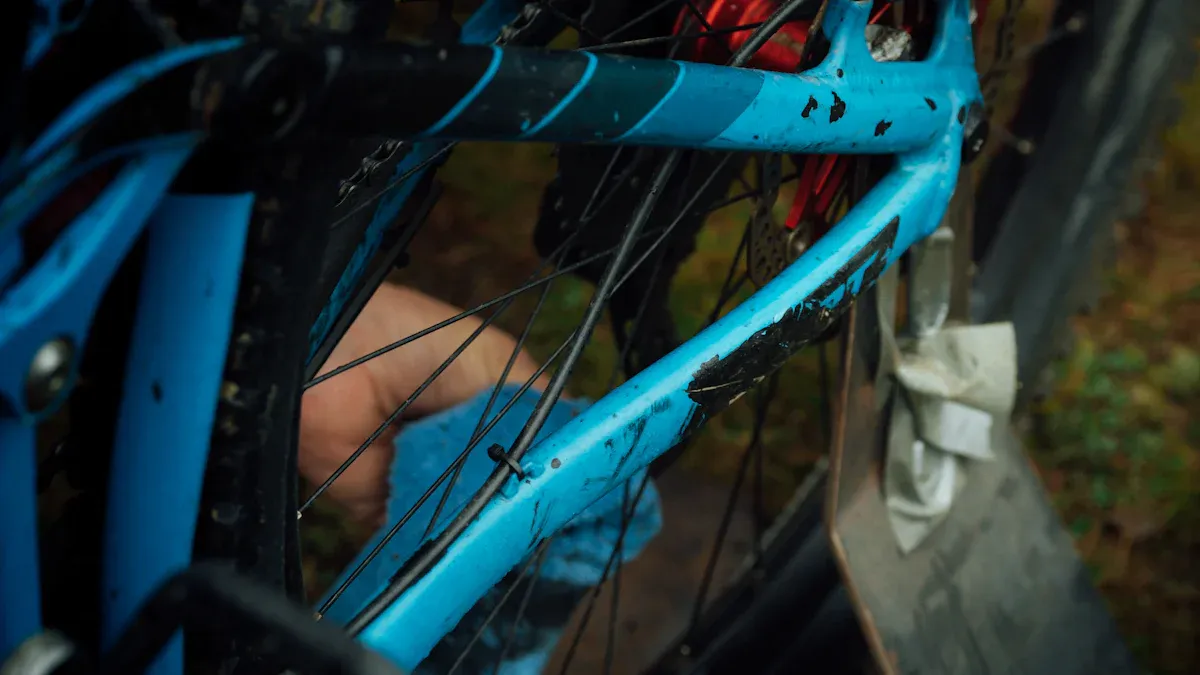
Frame Structure
When you look at a bicycle, the frame stands out as the backbone. It holds all the other bike frame parts together and shapes how your ride feels. The frame splits into two main sections: the front triangle and the rear triangle. Each section uses different tubes and joints to give the bike its strength and shape.
Here is a table showing the main tubes in the front triangle and what they do:
Tube | Function and Role |
|---|---|
Top tube | Connects the top of the head tube to the top of the seat tube; provides structural support; routes control cables (e.g., rear brake); affects frame geometry and rider fit. |
Down tube | Connects the head tube to the bottom bracket shell; mounts for bottle cages and sometimes pumps; cable routing for derailleurs and brakes on some bikes. |
Seat tube | Runs vertically from bottom bracket to seat post; holds the seatpost and saddle; adjustable saddle height; may have mounts for bottle cages or front derailleurs. |
The rear triangle includes the seat stays, chain stays, and rear dropouts. These parts connect the back wheel to the frame and help support your weight.
Frame geometry shapes how your bike handles. The length of the top tube and down tube, the angle of the head tube, and the wheelbase all play a role. A longer top tube and wheelbase make the bike more stable at high speeds. A shorter top tube and steeper head tube angle make the bike more agile for tight turns. You can see these changes in different types of bikes, like mountain bikes for rough trails or road bikes for speed.
The material of your bike frame also matters. Steel frames feel strong and last a long time, but they weigh more. Chromoly steel is a lighter type of steel that still gives you strength. Aluminum frames weigh less and feel stiffer, but they may not last as long, especially in wet weather. Carbon fiber frames are very light and tough, but they can break if not made well. The choice of material changes the weight, comfort, and durability of your bicycle.
Tip: If you want a comfortable ride, look for a frame with the right geometry and material for your riding style and terrain.
Understanding these bike frame parts helps you choose the right bike and keep it in good shape. This knowledge forms the base of bicycle anatomy.
Fork
The fork connects the front wheel to the frame. It lets you steer and helps absorb bumps from the road or trail. The fork has two blades that hold the wheel and a steerer tube that fits into the frame’s head tube.
The fork’s design affects how your bike handles. A rigid fork, often found on road bikes, feels light and stiff. It gives you quick steering but sends more bumps to your hands. Suspension forks, common on mountain bikes, use springs or air to absorb shocks. This makes rough rides smoother and helps the wheel stay on the ground.
The fork’s angle and length also matter. A steeper angle makes the bike turn faster. A slacker angle gives you more stability on rough ground.
Fork materials change the ride. Steel forks feel springy and comfortable. Aluminum forks are stiff and light but can feel harsh. Carbon fiber forks are very light and can soak up small vibrations, but they may feel rough on bumpy roads if not made well.
Here are some key roles of the fork:
It connects the front wheel to the frame and lets you steer.
It absorbs shocks and vibrations, making your ride smoother.
It affects how quickly and accurately you can turn.
Suspension forks improve comfort and control on rough terrain.
Choosing the right fork depends on where you ride and what you want from your bike. Softer forks work well for rough roads, while stiffer forks suit smooth surfaces and fast riding.
Headset
The headset is a small but important part of bicycle anatomy. It sits inside the head tube of the frame and lets the fork and handlebars turn smoothly. The headset uses bearings to reduce friction, so you can steer with ease.
The height of the headset, set by spacers, changes how your bike feels. More spacers raise the handlebars, moving your weight back and making the bike feel more stable. Fewer spacers lower the bars, shifting your weight forward for quicker steering.
The headset type and design also affect how the bike handles. A well-adjusted headset gives you precise control and makes the bike feel like an extension of your body.
Note: Check your headset often. If it feels loose or rough, adjust or replace it to keep your steering safe and smooth.
Knowing how these bike frame parts work together helps you understand bicycle anatomy. You can spot problems early, make better choices when buying or upgrading, and enjoy a safer, more comfortable ride.
Steering Parts
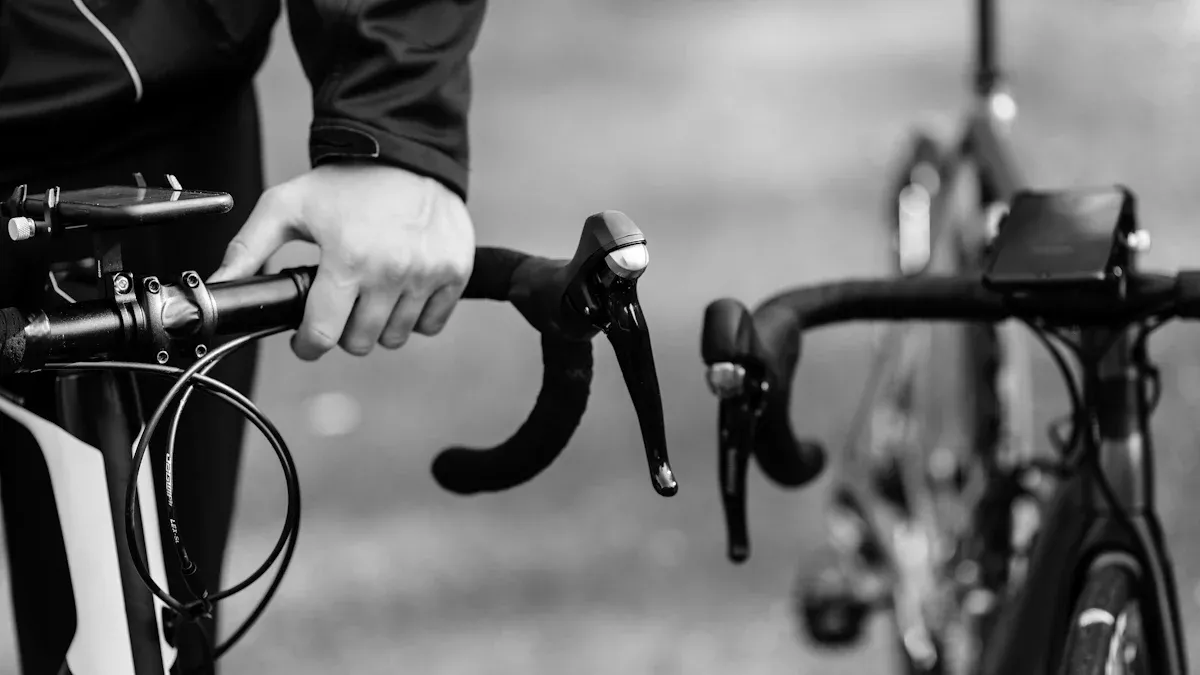
Stem
The stem is one of the most important parts of your bike’s steering system. You find it connecting the handlebar to the fork’s steerer tube. This connection lets you control the direction of your bike with ease. The stem also helps set your riding position, which affects comfort and control.
The length of the stem changes how your bike handles. A longer stem gives you more stability at high speeds and helps you stretch out for better aerodynamics. You might notice that your bike feels steadier when riding fast. A shorter stem makes your bike more responsive and easier to turn, which helps on technical trails or tight corners. You get quicker steering but less stability at high speeds.
The right stem length keeps your weight balanced between the front and rear wheels. This balance helps you stay in control and ride safely. If the stem is too long or too short, you may feel discomfort or lose control. You should choose a stem based on your riding style, bike type, and your body’s shape. Sometimes, you need to test different stems to find the best fit.
Tip: Adjusting your stem can improve comfort and power transfer. Always check that your stem is tight and secure before you ride.
Handlebars
The handlebar is the part you grip to steer your bike. You use it to control direction, balance, and comfort. Different handlebar shapes change how your bike feels and how your body sits while riding.
Here is a table showing common handlebar types and their effects:
Handlebar Type | Shape Characteristics | Typical Use | Ergonomic Impact |
|---|---|---|---|
Drop Bars | Curved forward/down | Road racing | Multiple hand positions; aerodynamic; less comfort for beginners |
Flat Bars | Straight/slightly curved | Mountain/urban bikes | Direct control; fewer hand positions; can cause fatigue |
Riser Bars | Rise upward from clamp | Mountain/casual riding | Upright posture; less wrist strain; better visibility |
Bullhorn Bars | Curve up/forward | Time trials | Aerodynamic; multiple hand positions; balance comfort/speed |
Clip-on Bars | Attach to existing bars | Mixed terrain | Quick position changes; reduces upper body fatigue |
Gravel Bars | Blend flat/drop bars | Gravel/mixed terrain | Wider grip; multiple hand positions; comfort/control |
You should match the handlebar width to your shoulders for better comfort. Drop bars let you change hand positions and ride in a low, fast posture. Flat bars give you direct control but fewer hand positions, which can tire your arms. Riser bars help you sit upright and see better, making rough terrain easier. Bullhorn and clip-on handlebars offer more ways to grip and switch positions, which helps on long rides. Gravel bars combine features for mixed terrain and comfort.
Note: Choosing the right handlebar improves your comfort and control. Try different shapes to find what works best for your riding style.
The stem and handlebar work together as key parts of your bike’s steering system. When you understand these parts, you can adjust your bike for better handling and comfort.
Seating Parts
Seatpost
The seatpost joins your saddle to the bike frame. It lets you change how high you sit. This part is important for comfort, especially on long rides. Seatposts can be made from aluminum, carbon fiber, or titanium. Aluminum seatposts are strong and light. They give steady support but only some comfort. Carbon fiber seatposts are lighter and soak up road bumps well. This helps your body feel less tired after riding far. Titanium seatposts are strong and bend a little. They also absorb shocks. Many riders like titanium for long hours on the bike.
Some seatposts are made to give extra comfort and control:
Flex and suspension seatposts help with bumps and make you less tired. These are good if your bike has thin tires.
Dropper seatposts let you change saddle height while you ride. This helps you handle different ground easily.
Seatpost offset, or setback, moves your seat back or forward. This can make you more comfortable if set up right.
Some new seatposts, like Trek’s IsoSpeed or Giant’s D-Fuse, have special shapes. These shapes help make your ride smoother.
Tip: Getting a bike fitting from a pro can help you pick the best seatpost and set it up for your body.
Saddle
The saddle is the seat you sit on. It needs to fit your body well. A good saddle supports your sit bones and lowers pressure on soft spots. Comfort depends on the saddle’s shape, width, and padding. On long rides, your sit bones and pressure points can change as you move and get tired. Saddles that do not adjust may cause pain or numbness.
You can make your ride better by looking for these features:
Adjustable saddles let you change the width and shape. This helps you ride longer and recover faster.
The right fit starts with measuring your sit bone width. Do not guess.
Firm padding and smart design stop rubbing and pressure better than soft, thick padding.
Saddles with center cutouts can lower pressure. These help many female riders, but you should try them yourself.
Test different saddles on several rides to find the best one.
Some bike shops let you return saddles or have saddle libraries. You can try before you buy.
Note: Saddle comfort is different for everyone. What feels good for one rider may not work for another. Take time to test different saddles and setups.
Drivetrain Components
The drivetrain is the system that moves your bike forward. It includes several important parts that work together to transfer your pedaling power to the wheels. Understanding these parts helps you keep your bike running smoothly and choose the right setup for your riding style.
Bottom Bracket
The bottom bracket sits inside the frame and connects the crankset to the bike. It holds bearings that let the crank arms spin smoothly. When you pedal, the bottom bracket supports heavy loads and reduces friction. High-quality bearings make your pedaling more efficient by letting you use less energy. If you hear creaks or feel resistance, your bottom bracket may need cleaning or replacement. Keeping this part in good shape helps you ride faster and with less effort.
Crankset
The crankset is the set of arms and chainrings attached to the bottom bracket. You push on the pedals, which turn the crank arms and move the chain. Cranksets come in different types, each affecting your gear range and performance. Here is a table to help you compare:
Crankset Type | Chainring Setup | Gear Range | Weight & Complexity | Best Use |
|---|---|---|---|---|
Single (1x) | 1 chainring | Limited | Light, simple | Gravel, time trials |
Double (2x) | 2 chainrings | Balanced | Moderate | Road, endurance |
Triple (3x) | 3 chainrings | Wide | Heavy, complex | Touring, steep climbs |
Choosing the right crankset lets you match your gear range to your terrain. A single crankset is simple and light, but a triple gives you more gears for tough hills.
Chain
The chain links the crankset to the cassette. It moves as you shift gears and must stay clean and well-oiled. Solid chains last longer and are easier to fix than hollow ones. Wider chains are stronger and need less care, while thinner chains work best with more gears but may wear out faster. The chain is one of the hardest-working parts in your drivetrain.
Cassette
The cassette is the group of sprockets on your back wheel. It controls how hard or easy it is to pedal. A cassette with a wide range of tooth sizes gives you more gear choices for hills and flat roads. More sprockets mean smoother shifting and better control. If you ride on flat ground, a narrow-range cassette helps you keep a steady cadence. For mixed or hilly terrain, a wide-range cassette gives you the gears you need.
Derailleurs
Derailleurs move the chain between gears. The front derailleur shifts the chain between chainrings, and the rear derailleur moves it across the cassette. These parts help you find the right gear for any situation. Good derailleurs make shifting smooth and quick. Modern designs, including electronic versions, give you even more precise control. Keeping your derailleurs clean and adjusted ensures your drivetrain works at its best.
Tip: Regularly check all drivetrain parts for wear. Clean and lubricate them to keep your gear changes smooth and your rides enjoyable.
Wheels and Brakes
Wheels
You depend on your wheels for every ride. Each wheel supports your weight, absorbs bumps, and helps you move forward. Wheels have three main parts: the hub, the rim, and the spokes. These parts work together to give you a smooth, stable ride. The right wheels can make your bike faster, more comfortable, and safer.
Hub
The hub sits at the center of your wheel. It lets the wheel spin around the axle. A good hub makes your ride feel smooth and efficient. Here is how hub quality affects your ride:
The hub controls how quickly your power moves the wheel. More engagement points mean faster response when you pedal.
High-quality hubs use smooth bearings. These reduce rolling resistance and help you ride with less effort.
Better hubs last longer and need less maintenance, especially if they use cartridge bearings.
Upgrading your hub can make your bike feel stiffer and more direct, giving you better control.
When you choose a hub, think about how much you ride and what kind of riding you do. A strong, smooth hub helps you enjoy every mile.
Rim
The rim is the outer circle of the wheel. It holds the tire and forms the braking surface for rim brakes. Rim material and shape change how your bike feels and stops. Aluminum rims give you reliable braking and are easy to care for. Carbon fiber rims are lighter and more aerodynamic, but they need special brake pads and can be harder to fix. Deeper rims help you go faster by cutting through the air, but they add weight. Wider rims support wider tires, making your ride more comfortable and stable, especially on rough roads.
Spokes
Spokes connect the hub to the rim. They spread your weight and the forces from bumps across the wheel. More spokes make the wheel stronger and better for heavy loads or rough ground. Fewer spokes make the wheel lighter and faster, but not as strong. The way spokes cross each other, called the lacing pattern, also changes how the wheel handles bumps and weight.
Front Spoke Count | Rear Spoke Count | Reason | |
|---|---|---|---|
Road Racing / TT | 16–18 | 20–24 | Maximum aerodynamics |
General Road / Endurance | 20–24 | 24–28 | Balance of strength and speed |
Gravel / Heavier Riders | 24–28 | 28–32 | Extra strength and comfort |
Touring / Bikepacking | 32–36+ | 32–36+ | Maximum load and durability |
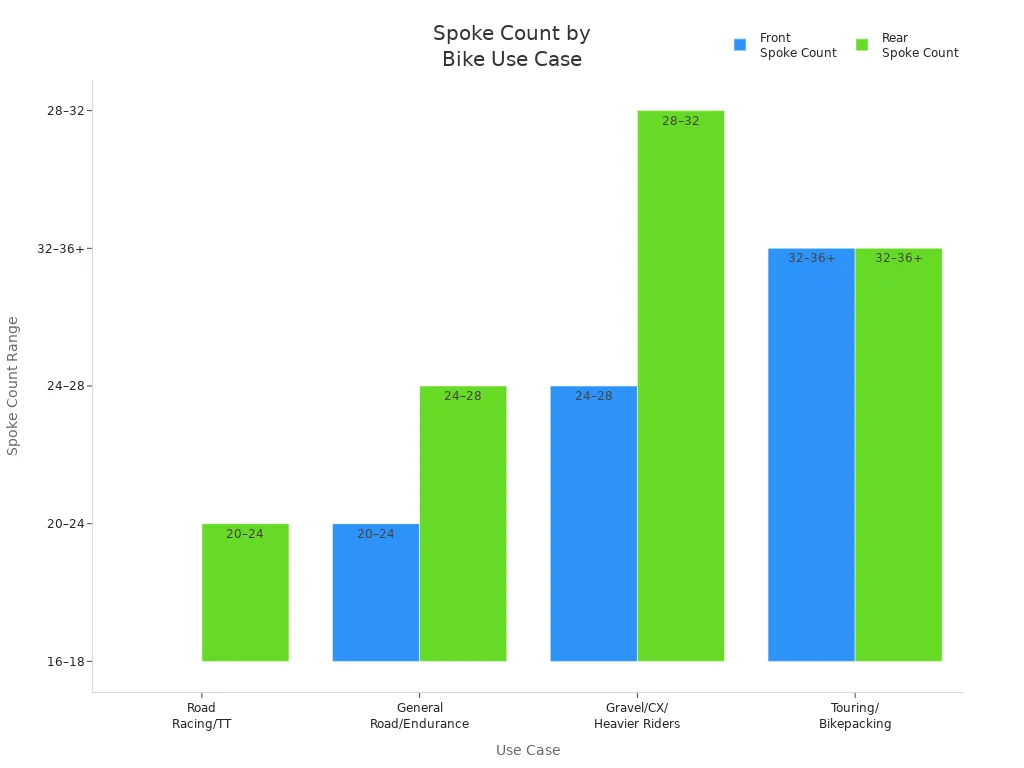
Brakes
Brakes are safety-critical parts. They help you slow down and stop your bike. You will find two main types: rim brakes and disc brakes. Each type has its own strengths and weaknesses.
Rim Brakes
Rim brakes press pads against the rim to slow the wheel. They are light, simple, and easy to fix. Rim brakes work well in dry weather and are affordable. In wet or muddy conditions, rim brakes lose power and can wear out the rim over time. You may notice a delay before the pads grip the rim when it rains. This can make emergency stops harder. Aluminum rims give better braking with rim brakes than carbon rims.
Rim brakes are best for dry weather and flat roads.
They are easy to maintain and cost less to repair.
You need to replace pads often and check for rim wear.
Disc Brakes
Disc brakes use pads to squeeze a metal rotor attached to the hub. They give you strong, steady stopping power in all weather. Disc brakes work well in rain, mud, and on steep hills. You get better control and can use wider tires. Disc brakes are heavier and more complex. They cost more and need special tools for repairs. Sometimes, the rotor can bend or rub.
Disc brakes are great for mountain biking, gravel, and wet conditions.
They last longer and do not wear out the rim.
You need to learn more to fix and adjust them.
Tip: Choose disc brakes if you ride in all weather or need strong stopping power. Rim brakes are a good choice for simple, dry rides.
Knowing your bike’s frame parts helps you find cracks or rust early. You should check your bike often, especially where tubes join. This keeps you safe and saves money on repairs. Use a torque wrench so you do not break small parts. If you need more help, bike shops can clean and fix your bike for different prices.
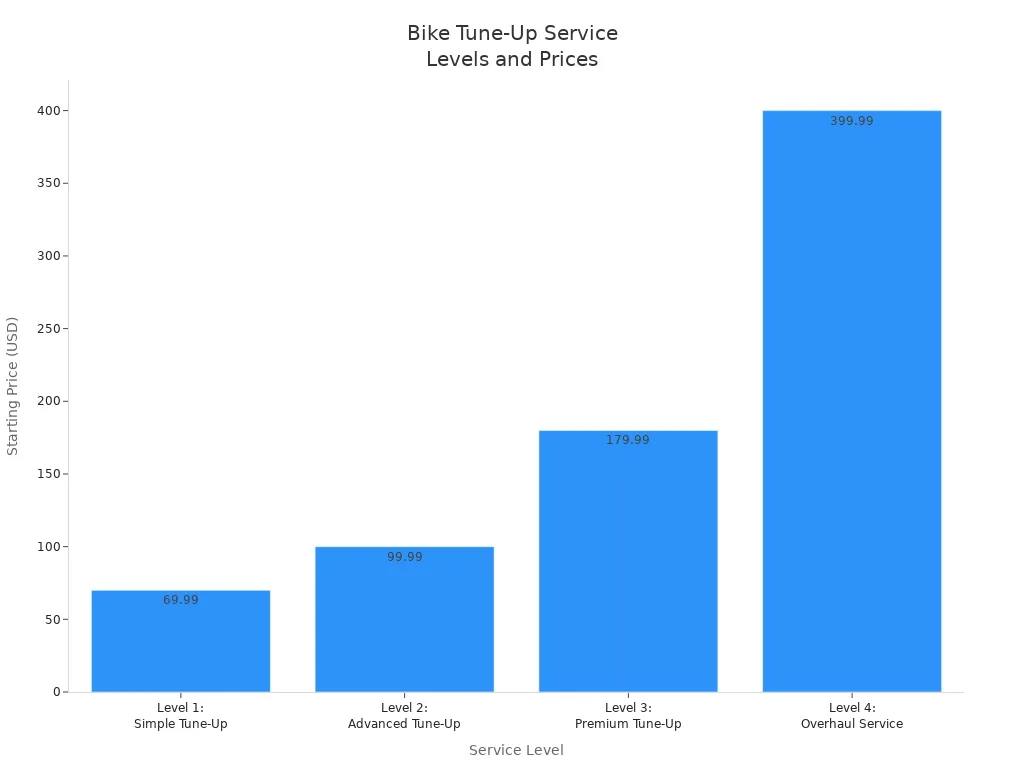
Keep learning about bikes and ask experts if you are unsure. When you know more, you feel sure and enjoy riding even more.
FAQ
What is the most important bike frame part to check for safety?
You should check the frame joints and welds first. Cracks or rust in these spots can cause sudden breaks. Use a flashlight to look closely. If you see damage, visit a bike shop.
How often should you inspect your bike frame and parts?
You need to inspect your bike every month. Look for loose bolts, cracks, and rust. Clean your bike after wet rides. Regular checks help you catch problems early.
Can you upgrade just one bike frame part for better comfort?
Yes, you can swap your saddle or seatpost for more comfort. Many riders feel less pain after changing these parts. Try different shapes and materials to find what fits you best.
What is the difference between rim brakes and disc brakes?
Rim brakes grip the wheel rim to stop you. Disc brakes squeeze a metal disc near the hub. Disc brakes work better in rain and mud. Rim brakes are lighter and easier to fix.
How do you know which bike frame material is best for you?
Choose steel for strength and comfort. Pick aluminum for light weight and speed. Carbon fiber gives you the lightest ride. Test bikes with different materials to see which feels best.
See Also
Key Tips For Protecting Your Bike Frame Effectively
Simple Bike Frame Fitting Tips To Enhance Comfort
Best Materials For Electric Bike Frames And Benefits
